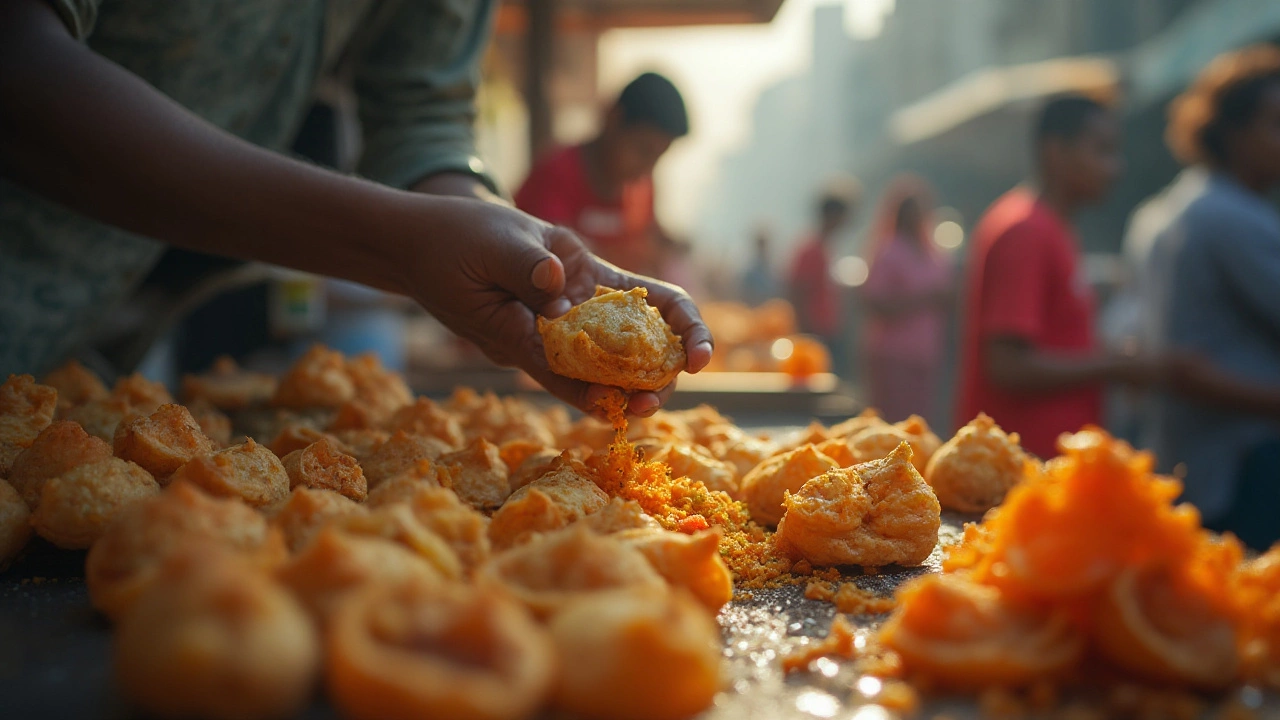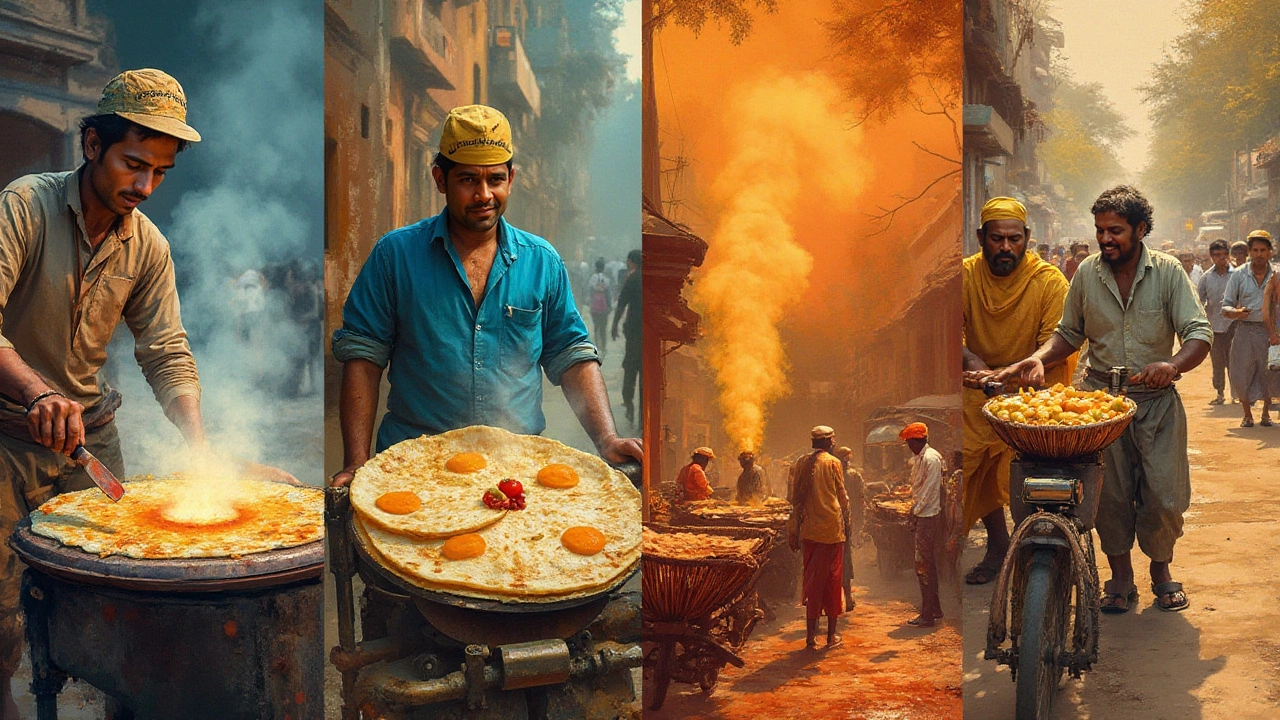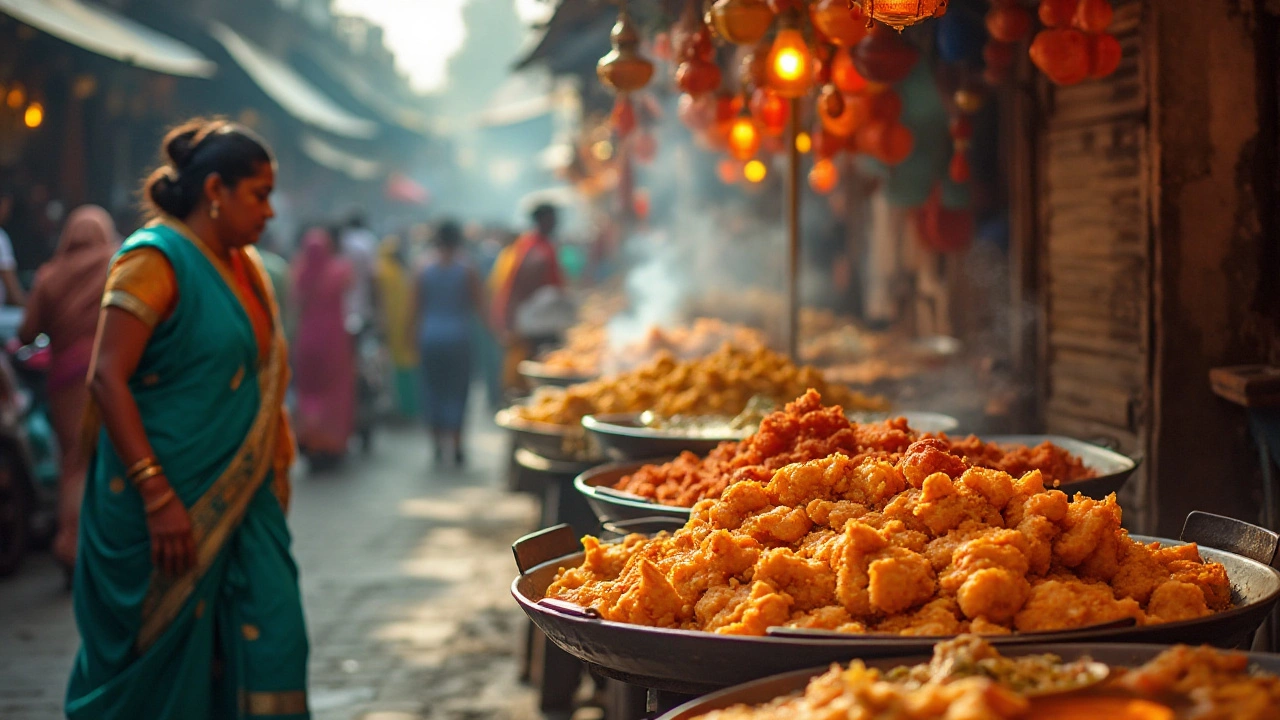Indian street food is a delightful symphony of flavors, colors, and aromas that captivates anyone who encounters it. Steeped in tradition yet constantly evolving, this aspect of Indian cuisine tells stories of both the past and present. In the bustling streets and alleyways of India, vendors craft a myriad of dishes that are as diverse as the country's language and traditions.
With every bite, street food offers a taste of the local culture, and the variety is nothing short of astounding. From tangy chaat to savory samosas, there's something for every palate. Understanding the intricate layers of these street-side treasures not only enriches the soul but also enhances the culinary journey across India.
- The Diversity of Indian Street Food
- Popular Street Food Dishes
- Regional Specialties and Their Origins
- The Art of Street Food Preparation
- Tips for Enjoying Street Food Safely
The Diversity of Indian Street Food
When you wander through the streets of India, one cannot help but notice the intoxicating aroma of sizzling spices and freshly cooked delights. Indian street food showcases a remarkable array of dishes, each with distinctive flavors reflective of the region's specific culture and history. From the bustling streets of Delhi to the serene alleyways of Kerala, every street food captures the essence of its surroundings and brings forth a new flavor profile. The relentless creativity of street vendors contributes significantly to this variety, offering both comfort and excitement in every bite. In the heart of these streets, there is a magical merging of influences where innovation meets tradition, and age-old recipes are reimagined for contemporary palates.
On the streets of Mumbai, you might indulge in a vada pav, often likened to an Indian burger, packing a zesty punch with each bite. Moving towards Kolkata, the kathi rolls beg to be tried, marrying flaky parathas with savory fillings. Such diversity is not just about flavors but also textures that cater to diverse preferences—crispy, spicy, sweet, or savory. This kaleidoscope of choices allows each vendor to express a unique culinary style and heritage. In Varanasi, for instance, chaat stands are plentiful, and each offers a slightly varied rendition of this beloved dish, teasing the taste buds with a fusion of sweet, sour, and spicy flavors.
Street food culture in India is an integral part of everyday life, where quick bites symbolize quick exchanges and social interactions. “Street food tells the eternal story of humankind's endless journey towards happiness,” said Madhur Jaffrey, a highly respected voice in Indian cuisine. The flavors written across the Indian street food landscape are testimonies of resilience, adaptation, and the evolving nature of Indian society and taste. The choices are ever so diverse that they cater to the most basic of needs and the most adventurous of cravings, forever keeping the spirit fresh and alive.
| Region | Popular Street Snack |
|---|---|
| Delhi | Aloo Tikki |
| Mumbai | Pav Bhaji |
| Chennai | Idli Sambhar |
| Kolkata | Puchka |
The influence of Indian street food reveals how geography impacts the style of cooking and ingredients used. Coastal regions, like Goa, boast seafood-centric dishes, bursting with freshness and spice. Northern parts pride themselves on dishes with bold flavors and a heavy use of dairy and ghee, as seen in buttery parathas and rich, sweet desserts. Each dish tells a tale of the land it comes from, a narrative served on a plate with warmth and a dash of chaos that is typically Indian. This vibrant mosaic of flavors and cooking techniques is seasoned with community essence, where food becomes more than nourishment; it becomes an experience, a memory shared among the crowd bustling through India's streets every day.
Popular Street Food Dishes
In the bustling streets of India, the allure of Indian street food lies in its tantalizing array of flavors and textures. Everywhere you look, vendors line the streets, offering bites of culinary adventures that beckon with the promise of authentic taste experiences. One cannot walk through these vibrant streets without encountering the renowned 'panipuri'—a crispy sphere filled with tangy tamarind-infused water, potatoes, and chickpeas. This beloved snack, known by various names across India, boasts a spicy and sour kick that is both refreshing and exhilarating. Another favorite is the lip-smacking 'chole bhature', a dish featuring spicy chickpeas paired with deep-fried bread, often garnished with onions and a lemon wedge. Its hearty nature makes it not just a snack but a fulfilling meal as well.
Amidst these street-side delights, 'dosa'—a South Indian staple—stands tall, its pancake-like exterior crisp and golden, often stuffed with spicy potatoes and served with coconut chutney and tangy sambar. There's nothing quite like grabbing a quick dosa from a local stall for a burst of savory satisfaction. For those with a sweet tooth, Indian streets provide an array of options. One cannot ignore 'jalebi', a bright orange sweet made by deep-frying flour batter into circular shapes and soaking them in sugar syrup. Its crunchy and syrupy texture makes it a delightful indulgence. Another sweet affair comes in the form of 'kulfi', a rich and creamy ice-cream-like dessert, often infused with exotic flavors like saffron and cardamom.
Indian street food is as diverse as it is delightful, capturing the heart of its cultural fabric. Take 'kachori', for instance, a deep-fried snack stuffed with spicy lentils or peas that offer a satisfying crunch with each bite. Often accompanied by tamarind or mint chutney, kachoris are a delightful treat any time of the day. Meanwhile, 'bhel puri', a chatpata mix of puffed rice, vegetables, and tangy tamarind sauce, presents a burst of flavors and textures. Served in paper cones, this snack is emblematic of Mumbai, where it's enjoyed by college students and office-goers alike.
Each region showcases its specialties, illustrating the sheer variety and depth of India's culinary heritage. The vibrant streets of Kolkata tempt with 'puchka', while the bylanes of Delhi boast the best 'parathas'. And all across Rajasthan, spicy 'mirchi vada' captures the essence of the state's penchant for fiery flavors. As the sun sets, the sizzling sounds of meats being prepared for 'kebabs' fill the air—a testament to the masterful blend of spices and techniques perfected over generations. One can argue that these mouthwatering dishes are not just food; they represent a way of life. As the famous Indian chef and restaurateur, Sanjeev Kapoor, once said,
"Street food in India is not only a reflection of its culinary diversity but also the warmth and generosity of its people."

Regional Specialties and Their Origins
India's street food scene is a reflection of its sprawling geography and diverse cultures, each region offering its own distinct specialties that have been honed over centuries. From the tangy chaats of Delhi to the fiery vadas of South India, every corner of the country has flavors that tell tales of history, migration, and innovation. Northern India prides itself on its variety of chaats, which originated in the royal kitchens during the Mughal era. These savory snacks, bursting with a mix of spices, flavored water, and crunchy textures, provide a refreshing food experience that has captivated millions.
In the eastern part of India, particularly in the state of West Bengal, one cannot overlook the beloved puchka, known in Delhi as golgappa and as pani puri in Mumbai. This tantalizing snack has its roots in the ancient kingdom of Magadha, where it was believed to have been first served. The crispy, hollow puris filled with spicy tamarind water have transcended regions, each area adding its own twist. Moving to the west, the streets of Gujarat are known for their addiction to dhoklas and fafdas, which are not just popular snacks but also a cultural emblem of hospitality during festivals.
Venture further south, and the aroma of dosa, a type of fermented crepe, wafts through the air. Native to Tamil Nadu, the art of dosa-making has been passed down through generations, each still holding on to the traditional methods, yet welcoming slight innovations now and then. Dosas, along with idlis and vadas, form an integral part of South Indian street food culture. As noted by Darlene Schmidt of The Spruce Eats, "The Indian cuisine was intensely distinct from region to region, demanding a study in geographical culinary identity."
In Maharashtra, the iconic pav bhaji tells of the industrial era in Mumbai, when textile mill workers needed a quick yet nutritious meal. A melange of mashed vegetables and spices paired with buttered bread, pav bhaji’s origin is a testament to the city’s industrious spirit and culinary adaptability. While in Mumbai, you'll notice vada pav vendors at every corner, offering a taste of what is often humorously referred to as the Indian burger. Unsurprisingly, Mumbai's street foods reflect a blend of influences due to its cosmopolitan nature.
Each street food item in India carries a legacy, a story passed down through time. These dishes are not mere food; they are cultural artifacts, a delicious documentation of India's vast and varied historical tapestry. Whether it's through the simplicity of a bhelpuri on a beach or the complexity of a biryani in a bustling market, Indian street food continues to intrigue and delight, offering deeper insights into the soul of its regions.
The Art of Street Food Preparation
In the heart of Indian markets and along bustling streets, the art of street food preparation comes to life, captivating locals and travelers alike. The magic begins with the ingredients, often sourced fresh from local markets each morning. Vendors pride themselves on using seasonal produce and spices, carefully balancing flavors to create perfect culinary harmony. These artisans have often honed their skills over decades, sometimes spanning generations, passing down recipes and techniques like treasured heirlooms.
The preparation process involves not only skill but also a deep understanding of textures and flavors. The sizzle of pakoras frying in bubbling oil, the rhythmic clink of metal ladles against woks, and the melodic calls of vendors, all form part of this unique symphony. The dexterity required to toss vegetables, meats, and spices into steaming hot pans or to fold, stuff, and fry dough, is both a science and an art. Each vendor brings a personal touch, a signature twist, often kept secret, which gives a dish its unique identity. As people gather around, the street becomes a stage, showcasing a culinary performance that entices passersby with its irresistible aroma.
There's something inherently communal about Indian street food. It's not just about grabbing a quick bite; it's about sharing a moment. The experience extends beyond the plate. Customers often engage in conversations with vendors, discover stories behind the recipes, and learn about the significance of certain ingredients. According to a popular saying in India, "Dilli ka chaat aur Mumbai ka vada pav bhula nahi jaate" – "The taste of Delhi's chaat and Mumbai's vada pav cannot be forgotten." This expression captures the essence of street food's lasting impact on those who indulge in it. As one walks away, the flavors linger, leaving an indelible impression.
The meticulous care in preparation also ensures respect for local traditions. Each recipe carries the legacy of the region it comes from. Weather and local palate play crucial roles in shaping these delights. Vendors adapt to the seasons, offering spicy delicacies in winter and refreshing drinks in summer. Some dishes, like Pani Puri, provide intrigue as they involve active participation from the eater, who must swiftly pop the entire delicacy into their mouth to experience the full burst of flavors. This involvement enhances the allure and adds another dimension to the enjoyment. It's a sensory experience, combining taste, texture, sound, and smell into an unforgettable journey.

Tips for Enjoying Street Food Safely
When it comes to savoring Indian street food, exercising a bit of caution and adopting a few savvy habits can vastly enhance your experience. The bustling, aromatic streets may draw you in with their vibrant offerings, but it's crucial to approach this culinary adventure with a keen eye for hygiene. One of the first things to look out for is the vendor’s setup. Cleanliness is paramount, so check if the stall is regularly maintained. If possible, choose stalls busy with locals, as high turnover often means fresh ingredients are being used. A popular saying amongst seasoned street food enthusiasts is "when in doubt, ask a local." They will often steer you towards the best spots.
When inspecting a street food stall, observe how the vendor handles the dishes. A responsible vendor uses gloves or utensils to serve food rather than bare hands. While street food can be prepped right before your eyes, ensuring that it is cooked thoroughly is key to avoiding any unwanted tummy troubles. Steaming hot foods are less likely to harbor germs, so prioritize dishes that are cooked on the spot. The long lines at certain stalls may seem daunting, but they are often signs of well-loved and well-trusted bites. Freshness is a hallmark of quality in the streets—whether it’s the crispness of a samosa or the fluffiness of a pav.
Also, consider the timing of your street food jaunt. Visiting earlier in the day might present better options as ingredients are typically fresher in the morning. Hydration is another factor that's often overlooked. As tempting as it might be to quench your thirst with local beverages, stick to bottled water or drinks served in sealed containers to ensure safety. Among the drinks, lassi served in clean glasses can be a delightful choice, though vigilant inspection is recommended. One traveler remarked,
"The taste of street food should be an adventure, not a hazard."This captures the spirit of careful yet enthusiastic exploration.
On a more adventurous note, engage your senses beyond taste. Smell the spices, take in the artistry of food preparation, and learn from the vendor’s culinary expertise. It's a sensory journey that, when approached mindfully, adds depth to your travel tales. For those deciding to embark on this street food voyage, packing a hand sanitizer won’t hurt. A small bottle can be an invaluable companion to curb the spread of germs before a meal. Remain mindful of your surroundings; bustling streets may also call for vigilant observation of where and how you eat. By keeping these tips in mind, you can relish the diverse flavors of Indian street fare responsibly, delighting in each savorous encounter without regret.
